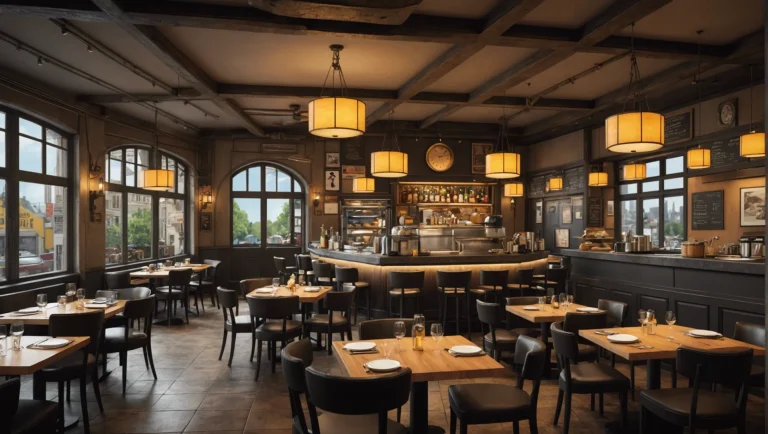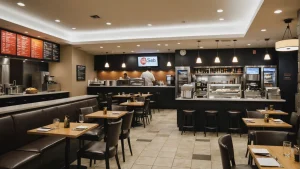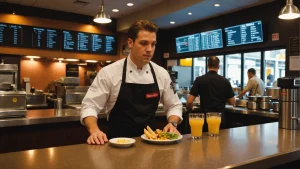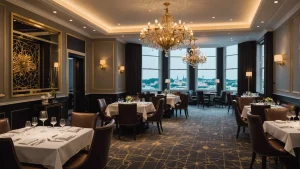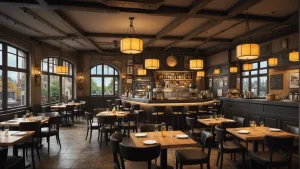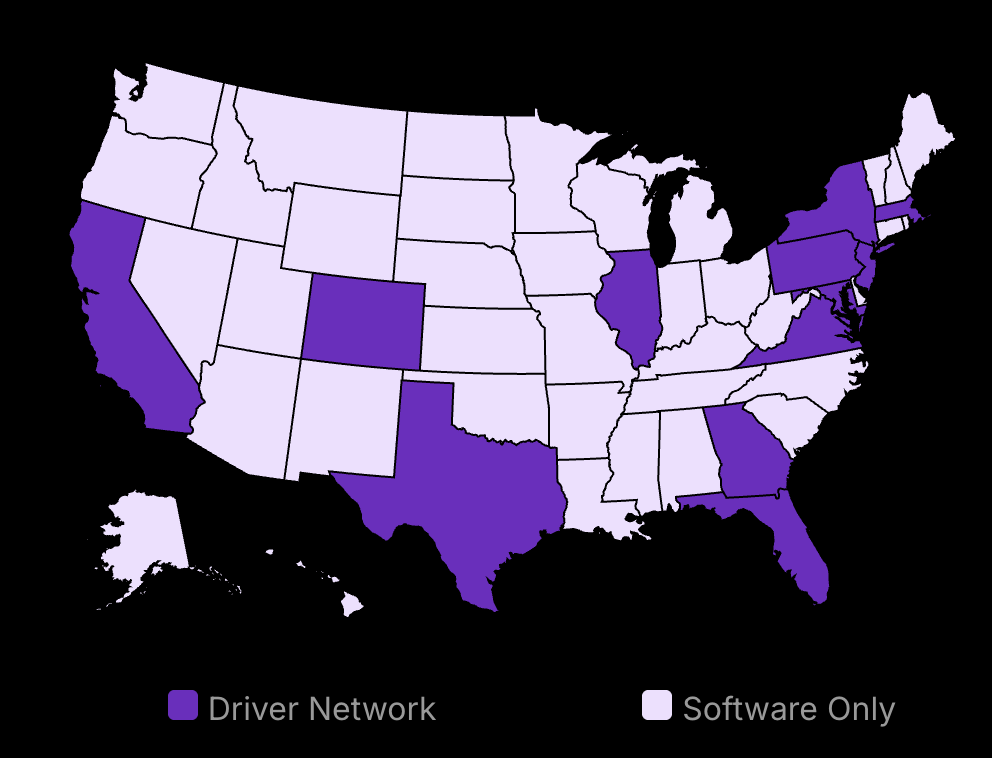Are you a foodie looking to explore the diverse world of restaurants? With so many options available, it can be overwhelming to navigate the culinary landscape.
In this guide, we’ll break down the 10 most popular types of restaurants, helping you understand the unique features and experiences each one offers.
From fast food joints to fine dining establishments, and everything in between, you’ll discover the perfect restaurant for any occasion or craving.
Whether you’re in the mood for a quick bite, a family-friendly meal, or an upscale dining experience, this article has got you covered.
So, let’s dive in and explore the delicious world of restaurants!

Lower your delivery costs by 23%
How we reduce costs:
- No delivery vehicle expenses
- Optimized local routes
- Pay-per-delivery model
- Average 23% delivery cost reduction
What Are the Main Types of Restaurants?
Types of Cuisine
Restaurants are often categorized by the type of cuisine they serve, such as Italian, Chinese, Mexican, or Indian. This cuisine-based categorization helps diners choose restaurants based on their food preferences and cravings. For example, if someone is in the mood for sushi, they can easily search for Japanese restaurants in their area.
According to a survey by Statista, the most popular foreign cuisines in the United States are:
1. Chinese (64%)
2. Italian (38%)
3. Mexican (54%)
4. Thai (24%)
5. Indian (11%)
Cuisine-based categorization also helps restaurants differentiate themselves in a crowded market. By specializing in a particular cuisine, restaurants can attract diners who are looking for authentic and high-quality dishes from that region.
Nearly 6 in 10 US Restaurants Serve American:
American cuisine makes up 59% of all restaurant types in the US.
Restaurant Service Styles
Another way to categorize restaurants is by the style of service they offer. The most common service styles include:
Fast food (quick service): Customers order at a counter, pay before eating, and receive their food quickly. Examples of quality food include McDonald’s and Subway. Curious about the quick convenience of fast food outlets? Learn more about the advantages and distinct elements of a quick service, or counter service, restaurant.
Casual dining (table service): Customers are seated and served by waitstaff, with moderately priced menus. Examples of counter service include Applebee’s and Olive Garden.
Fine dining (upscale, or full service restaurant.): Restaurants offer high-end cuisine, attentive service, and a formal atmosphere. Examples include The French Laundry and Eleven Madison Park.
The service style determines the level of formality, menu prices, and overall dining experience. Fast food restaurants are known for their speed and affordability, while fine dining establishments prioritize quality ingredients, culinary expertise, and personalized service.
Specialty Restaurants
Some restaurants specialize in specific dietary needs or food types, catering to niche markets and offering unique dining experiences. Examples of specialty restaurants include:
Vegetarian/vegan restaurants: These establishments serve plant-based dishes, appealing to diners who follow vegetarian or vegan diets.
Seafood restaurants: These restaurants focus on serving high-quality fish and shellfish dishes, often sourcing their ingredients from local fisheries.
Gluten-free restaurants: These eateries cater to diners with gluten sensitivities or celiac disease, offering menus free of wheat, barley, and rye.
According to a report by the market research firm Mintel, 52% of Americans who eat plant-based proteins do so because of taste, outranking concerns over diet, animal protection, the environment, and health. Specialty restaurants cater to this demand for novel dining experiences by offering unique and targeted menus.
By understanding the main types of restaurants, diners can make informed choices based on their preferences, dietary needs, and the occasion. Whether they’re looking for a quick bite, a casual meal with friends, or a high-end culinary experience, there’s a restaurant type to suit every taste and budget.
5 Popular Restaurant Concepts
Fast Food Restaurants
Fast food restaurants are known for their quick service and affordable, standardized menu items. Customers at contemporary casual restaurants typically place their orders at a counter and receive their food within minutes. These restaurants focus on efficiency, often using pre-prepared ingredients and streamlined cooking methods to ensure speedy service. Considering the swift and cost-effective dining experience fast-food establishments offer? Delve into how fast-service restaurants maintain their rapid operation and consistent quality.
Fast Food Nation:
65% of people consume fast food at least once a week.
Some of the most well-known fast food restaurant chains include McDonald’s, Burger King, and KFC. These restaurants offer a limited menu of burgers, fries, fried chicken, and other quick-serve items. Fast food restaurants are popular among consumers seeking a quick, inexpensive meal on the go.
Fast Food Fix:
13% of people consume fast food every day.
A Fast Food Classic:
24% of Americans believe that McDonald's has the best fast food french fries.
The Rise of Drive-Thrus
Drive-thrus have become an integral part of the fast food industry, allowing customers to order and receive their meals without leaving their vehicles. According to a study by the National Restaurant Association, drive-thru sales accounted for 70% of total restaurant sales in 2020, largely due to the COVID-19 pandemic and the increased demand for contactless service. Incorporating efficient route planning is crucial for drive-thru restaurants aiming to reduce wait times and enhance customer satisfaction. Effective route optimization strategies help streamline food delivery logistics, ensuring orders reach customers promptly and operations run smoothly.
Who Uses Drive-Thrus?
40% of American consumers use drive-thrus to purchase fast food.
53% of females prefer to go through the drive-thru when purchasing fast food, while only 26% of males use the drive-thru.
Casual Dining Establishments
Casual dining restaurants offer a full table service, and moderately priced menu items in a family-friendly atmosphere. These establishments typically feature a more extensive menu than fast food restaurants, with a variety of appetizers, entrees, and desserts.
Popular casual dining chains include Applebee’s, Chili’s, and Olive Garden. These restaurants often have a bar area and may offer happy hour specials or other promotions to attract customers. Casual dining restaurants are popular among families and groups of friends looking for a sit-down meal in a relaxed setting.
The Importance of Ambiance
Ambiance plays a crucial role in the success of casual dining restaurants. Factors such as lighting, decor, and music contribute to the overall dining experience. A study by the Journal of Foodservice Business Research found that customers who perceived a contemporary casual restaurant that’s ambiance positively were more likely to return and recommend the establishment to others.
Fine Dining Restaurant
Fine dining restaurants offer an upscale, full-service experience with gourmet cuisine and an elegant ambiance. These establishments often feature expertly crafted menus, extensive wine lists, and attentive service. Discover the essence of a gourmet dining establishment and uncover the distinct characteristics that elevate the fine dining experience to its esteemed status.
The Fine Dining Filter:
Only 25 restaurant concepts qualify as fine dining.
Michelin-starred restaurants are among the most prestigious fine dining establishments, with chefs like Thomas Keller (The French Laundry, Per Se) and Alain Ducasse (Alain Ducasse at The Dorchester, Le Louis XV) setting the standard for haute cuisine. Fine dining restaurants are popular among food enthusiasts and those seeking a memorable, high-end dining experience.
Fine Dining Food Quality:
Fine dining concepts receive more than six times the compliments as complaints regarding food quality.
The Art of Plating
In fine dining restaurants, the presentation of dishes is just as important as the taste. Chefs meticulously arrange each element on the plate to create a visually stunning composition. The art of plating has become increasingly popular on social media platforms like Instagram, with diners sharing photos of their beautifully presented meals.
Buffet-Style Restaurants
Buffet-style restaurants offer a self-service, all-you-can-eat format with a wide variety of dishes. Customers typically pay a fixed price and serve themselves from various food stations, which may include salads, entrees, desserts, and more.
Popular buffet chains include Golden Corral, Old Country Buffet, and Souplantation. These restaurants are popular among families and large groups, as they offer a diverse selection of foods to suit different tastes and preferences.
The Pros and Cons of Buffet Dining
While buffet-style restaurants offer variety and value, they also have some drawbacks. One concern is food safety, as the self-serve format can increase the risk of contamination if proper hygiene practices are not followed. Additionally, the all-you-can-eat nature of buffets may encourage overeating, which can contribute to obesity and other health issues.
Food Trucks and Pop-Up Restaurants
Food trucks and pop-up restaurants offer unique dining experiences that often blend traditional restaurant service with the flexibility of street food. These establishments can be found at festivals, events, and even in permanent locations, offering a diverse range of cuisines and flavors.
Food trucks, in particular, have gained popularity in recent years, with many cities hosting food truck festivals and events. Pop-up restaurants, on the other hand, often appear in temporary locations, offering a limited-time dining experience that can create a sense of urgency and exclusivity.
The Rise of Mobile Dining
The rise of food trucks and pop-up restaurants reflects a shift towards more flexible and mobile dining options. According to a report by IBISWorld, the food truck industry grew by 7.5% between 2015 and 2020, driven by consumer demand for unique and convenient dining experiences.
Unique Dining Experiences
Unique dining experiences encompass a wide range of establishments that offer something beyond the traditional sit-down meal. This can include dinner theaters, supper clubs, and even restaurants with unusual themes or settings.
Dinner theaters, for example, combine a meal with live entertainment, such as a play or musical performance. Supper clubs, on the other hand, often feature live music and a more intimate atmosphere. Themed restaurants, like those with a medieval or futuristic setting, offer a distinctive ambiance that enhances the dining experience.
Immersive Dining
Immersive dining experiences have become increasingly popular, with restaurants incorporating elements like virtual reality, interactive performances, and even scent and sound design to create a fully immersive environment. These unique experiences attract customers looking for something beyond the standard meal.
Factors That Influence Restaurant Classification
Price Point and Target Market
The price point of a restaurant is a crucial factor in determining its classification and target market. High-end, fine dining establishments typically have higher prices, catering to affluent customers seeking a luxurious dining experience. These restaurants often feature premium ingredients, skilled chefs, and attentive service, justifying the elevated cost.
On the other hand, casual dining restaurants offer more affordable prices, targeting a broader customer base. They provide a relaxed, casual atmosphere and approachable menu options, making them popular for family dinners, social gatherings, and everyday meals.
Fast-food and quick-service restaurants prioritize speed and convenience, offering budget-friendly meals at the lowest price points. These establishments aim to serve a high volume of customers quickly, appealing to those seeking a quick bite or value for money.
Service Style and Formality
The level of service and formality plays a significant role in restaurant classification. Fine dining restaurants offer the highest level of service, with well-trained staff, formal table settings, and attention to detail. Guests can expect personalized recommendations, wine pairings, and an elevated dining experience.
Casual dining restaurants provide a more relaxed service and family style,, with friendly waitstaff and a less formal atmosphere. The focus is on creating a comfortable and enjoyable dining experience, with efficient service and a welcoming ambiance.
Fast-casual restaurants bridge the gap between casual dining and fast food, offering a slightly higher level of service and quality than traditional fast-food chains. Customers often order at a counter but receive their meals at their table, with a focus on fresh ingredients and customizable options.
From Mac & Cheese to Cheesesteaks:
Cheese was found to be the most-used ingredient in American cuisine, featuring in 18% of menu items, followed by pork and chicken.
Menu Offerings and Cuisine Type
A restaurant’s menu offerings and cuisine type are essential factors in its classification. Fine dining restaurants often specialize in a particular cuisine or offer a carefully curated menu featuring high-quality, seasonal ingredients. These establishments may have award-winning chefs who create innovative dishes and present them artfully.
Casual dining restaurants typically offer a more extensive menu with a variety of dishes from different cuisines. These menus cater to a wide range of tastes and preferences, often including family-friendly options and classic favorites.
Fast-food restaurants have standardized menus with a limited selection of items, focusing on quick preparation and consistency across multiple locations. These menus often feature burgers, fries, sandwiches, and other handheld items that are easy to consume on the go.
Ethnic and Specialty Restaurants
Ethnic restaurants specialize in a specific cuisine from a particular country or region, such as Italian, Mexican, or Thai. These establishments offer an authentic dining experience, with traditional dishes, flavors, and cooking techniques representative of the cuisine. Examples include popular chains like Olive Garden for Italian cuisine and Chipotle Mexican Grill for Mexican cuisine.
Specialty restaurants focus on a particular type of food or dining style, restaurant categories such as seafood, steakhouses, or vegetarian/vegan restaurants. These establishments cater to specific dietary preferences or highlight a specific ingredient or cooking method.
Atmosphere and Decor
The atmosphere and decor of a restaurant contribute to its overall classification and dining experience. Fine dining restaurants often have elegant, sophisticated decor with soft lighting, high-quality furnishings, and tasteful artwork. The atmosphere of ghost restaurant is designed to create a sense of luxury and refinement.
Casual dining restaurants typically have a more relaxed and inviting atmosphere, with comfortable seating, modern decor, and a lively ambiance. These establishments often incorporate design elements that reflect their cuisine or theme, creating a distinct dining environment.
Fast-food restaurants prioritize functionality and efficiency in their decor, with bright lighting, simple furnishings, and a focus on quick turnover. The atmosphere is designed to encourage customers to order, eat, and leave promptly, maximizing the number of patrons served.
Unique Dining Experiences
Some restaurants offer unique dining experiences that set them apart from traditional classifications. These may include:
Interactive dining: Restaurants that involve customers in the cooking process, such as hot pot or Korean barbecue. Examples of virtual restaurant include Honey Pig for Korean barbecue.
Themed restaurants: Establishments that create an immersive dining experience based on a particular theme, such as a rainforest or a specific movie franchise. Examples include The Rainforest Cafe for a rainforest theme.
Pop-up restaurants: Temporary restaurants that operate for a limited time, often featuring innovative menus and unique locations. Examples of ghost restaurants include Dining in the Dark for a unique sensory experience.
The Importance of Understanding Restaurant Types
Understanding the various types of restaurants is crucial for diners, restaurant owners, and food critics alike. For diners, knowing the characteristics of different restaurant types helps them make informed decisions when choosing where to eat based on their preferences, budget, and the occasion. Whether it’s a casual family dinner, a romantic date night, or a business lunch, being familiar with restaurant types ensures that diners select an establishment that meets their specific needs and expectations.
Benefits for Restaurant Owners
Restaurant owners also benefit greatly from understanding restaurant types. By clearly defining their restaurant concept and target market, owners can make informed decisions about menu design, pricing, decor, and service style. This knowledge helps them create a cohesive brand identity and attract their desired clientele. For example, a restaurant owner planning to open a fine dining establishment will make vastly different choices compared to one opening a fast-casual eatery.
Defining Target Market
A clear understanding of restaurant types also enables owners to identify and cater to their target market effectively. By aligning their concept with the preferences and expectations of their desired customers, restaurants can create a loyal customer base and stand out in a competitive industry. This targeted approach can lead to higher customer satisfaction, positive word-of-mouth, and ultimately, increased profitability.
Importance for Food Critics and Reviewers
Food critics and reviewers also rely on a deep understanding of restaurant types to provide accurate and context-specific evaluations. When reviewing a restaurant, critics must consider the establishment’s intended concept and target market to assess its success in meeting those goals. For instance, a casual dining restaurant should not be held to the same standards as a fine dining establishment in terms of service, decor, or menu complexity.
Providing Valuable Insights
By understanding the nuances of different restaurant types, food critics can offer valuable insights to both diners and restaurant owners. Their reviews can help diners make informed decisions about where to eat based on their preferences and expectations, while also providing constructive feedback to restaurant owners on areas where they excel or need improvement within the context of their chosen concept.
Facilitating Effective Communication
Moreover, a shared understanding of restaurant types facilitates effective communication between diners, restaurant owners, and food critics. When everyone involved in the dining experience has a clear grasp of the characteristics and expectations associated with each restaurant type, it becomes easier to articulate preferences, provide feedback, and make recommendations. This common language helps bridge the gap between the various stakeholders in the culinary world, fostering a more enjoyable and satisfying dining experience for all.
Feel Lazy to Taste New Culinary Experiences? Try Delivery Only Restaurants:
23% of American consumers prefer getting fast food delivered, while 10% prefer to buy food online and pick it up at a restaurant.
Exploring the World of Dining
From fast food favorites to elegant fine dining experiences, the world of restaurants offers something for every taste and occasion. Understanding the different types of restaurants and what they offer can help you make informed decisions when dining out.
Choosing the Right Restaurant for You
Consider your preferences, budget, and the occasion when selecting a restaurant. Whether you’re in the mood for a quick bite, a family-friendly meal, or a gourmet experience, there’s a restaurant type that will suit your needs. Planning your dining destinations efficiently can enhance your overall experience. Using a reliable dining route planner helps you map out multiple restaurant visits, save time, and discover new spots along the way. If you’re curious about how to optimize your food explorations, check out our comprehensive guide to a smart dining route planner.
Discovering New Culinary Experiences
Don’t be afraid to step out of your comfort zone and try new types of restaurants. Exploring different cuisines and dining styles can broaden your culinary horizons and introduce you to new flavors and experiences.
What’s your favorite type of restaurant?
Share your go-to restaurant style and the dishes that keep you coming back for more. Who knows, you might just inspire someone else to discover their new favorite dining spot!

